
LESLIE BIBB TAKES THE HAMPTONS




































































































































































































LESLIE BIBB TAKES THE HAMPTONS


































































































































































































On a pristine stretch of coveted oceanfront, this limited collection of light-filled homes in the sky, designed by the visionaries Skidmore, Owings & Merrill (SOM), Ro et Studio, and Enea Garden Design, features stunning vistas in every direction.

NOW UNDER CONSTRUCTION
Three- to six-bedroom residences priced from $13 Million. Schedule a private preview at our Sales Lounge in Bal Harbour Shops. RivageBalHarbour.com 786.572.3441

Sales Lounge located at Bal Harbour Shops: 9700 Collins Avenue, Suite 368, Bal Harbour, FL 33154
THIS OFFERING. THIS CONDOMINIUM HAS ALSO BEEN REGISTERED WITH THE MASSACHUSETTS BOARD OF REGISTRATION OF REAL ESTATE BROKERS AND SALESPERSONS F-1284-01-01. RIVAGE BAL HARBOUR CONDOMINIUM is developed by Carlton Terrace Owner LLC (“Developer” or “Offeror”). This offering is made only by the Developer’s Prospectus for the Condominium. Consult the Developer’s Prospectus for the proposed budget, terms, conditions, specifications, fees, and Unit dimensions. Sketches, renderings, or photographs depicting use of space, design, furnishings, lifestyle, amenities, food services, club services, rental services, hosting services, finishes, materials, fixtures, appliances, cabinetry, soffits, lighting, countertops, floor plans, or art are proposed only, and the Developer reserves the right to modify or withdraw the same in its sole discretion. No specific view is guaranteed. No specific use of space is guaranteed. Pursuant to license agreements, Developer has a right to use the trade names, marks, and logos of: (1) The Related Group; and (2) Two Roads Development, each of which is a licensor. This is not intended to be an offer to sell, or solicitation of an offer to buy, condominium units to residents of any jurisdiction were prohibited by law. 2025 © Carlton Terrace Owner LLC, with all rights reserved.
FOUNDER | EDITOR-IN-CHIEF
SARAH G. HARRELSON
EXECUTIVE EDITOR
MARA VEITCH
HAMPTONS EDITOR
JACOBA URIST
EDITOR-AT-LARGE
JULIA HALPERIN
FASHION EDITOR-AT-LARGE
ALI PEW
SENIOR EDITOR
ELLA MARTIN-GACHOT
ASSOCIATE DIGITAL EDITOR
SOPHIE LEE
ASSISTANT EDITOR
SAM FALB
SOCIAL EDITOR
KRISTIN CORPUZ
ART DIRECTORS
CHAD POWELL
JUNIOR ART DIRECTOR
HANNAH TACHER
PRODUCTION ASSISTANT
JAMESON BALDWIN
COPY EDITOR
EVELINE CHAO
CHIEF REVENUE OFFICER
CARL KIESEL
VICE PRESIDENT OF SALES, ART + FASHION
LORI WARRINER
DIRECTOR OF BRAND PARTNERSHIPS
DESMOND SMALLEY
PUBLIC RELATIONS
ETHAN ELKINS, DADA GOLDBERG
MARKETING COORDINATOR
HAILEY POWERS
PREPRESS/PRINT PRODUCTION
PETE JACATY & ASSOCIATES

THIS IS CULTURED’S FOURTH YEAR celebrating the Hamptons in the form of a limited-edition broadsheet. We just can’t get enough.
That’s because there’s so much here. Each time we sit down to make these issues, we unearth new creative alcoves and reconnect with CULTURED regulars whose processes and interests have evolved. For our first issue of the 2025 season, we brought the endlessly watchable Leslie Bibb, a face you’ll remember from this winter’s The White Lotus phenomenon, out to East Hampton for a joyride with photographer Terence Connors. “I’m trying to stay in the moment and say yes—in summer and life,” she told us. That’s how we got her to brave the traffic.
Elsewhere in the issue, gallery goliath Larry Gagosian shares the books that have shaped him and gives us some exclusive insights into his first foray into bookselling as the new proprietor of BookHampton. Our Hamptons Editor Jacoba Urist dives into the practices of disparate artistic forces: Sanford Biggers and Zoya Cherkassky. Authors Tinx and Sarah Hoover share thoughts on motherhood in what is perhaps the most revealing conversation our Hamptons issue has seen yet. And collectors Sandy and Stephen Perlbinder, who will be honored at the Parrish in July, welcome us inside their treasure trove in Sagaponack.
What comes through most clearly in these conversations, profiles, and photo shoots is the endless and life-affirming creativity that still thrums throughout the East End. I hope the issue encapsulates that spirit.

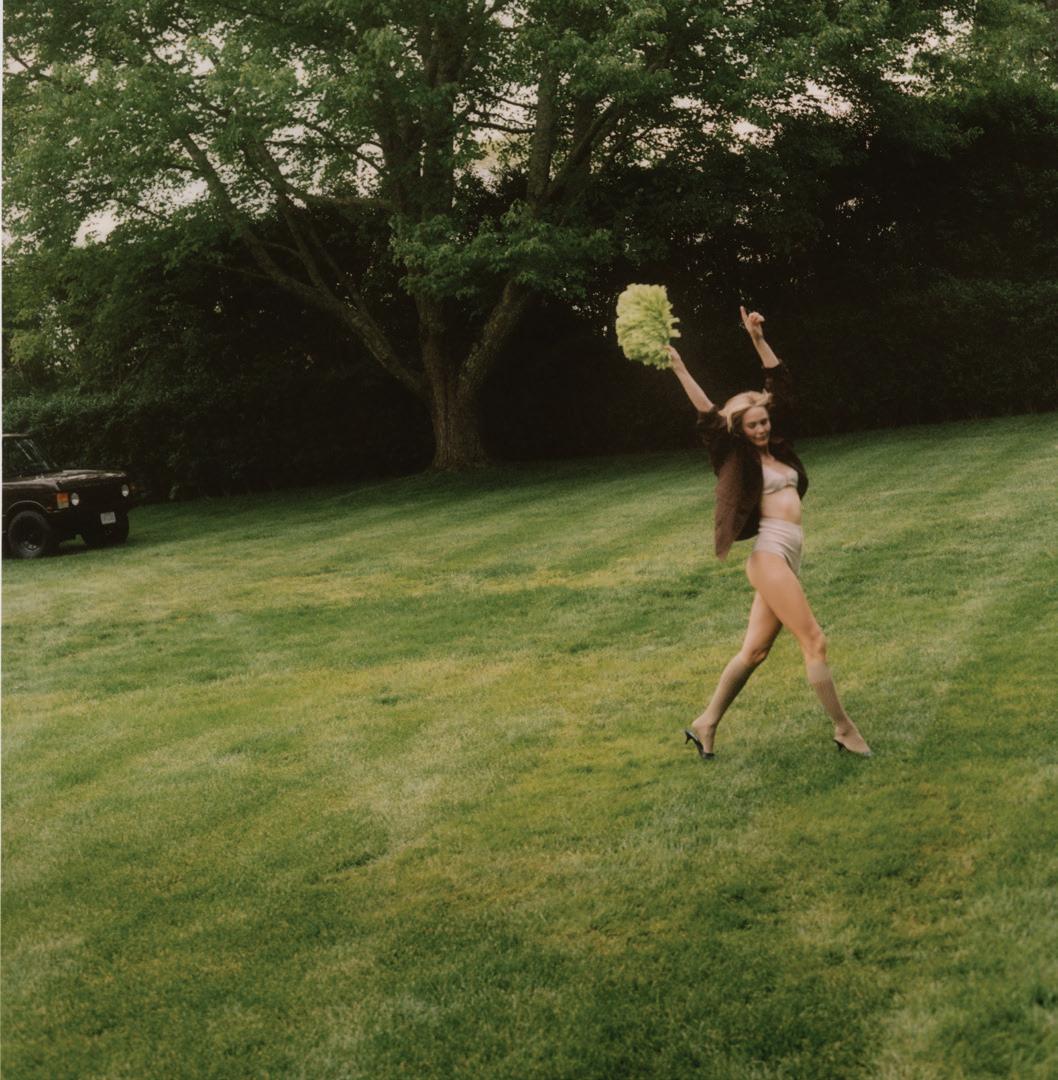
24
THE ART DIET
From the unexpected iconography of biblical saints to Louise Bourgeois’s sprawling spiders, the Hamptons’s summer art calendar offers a lush visual feast.
26
AMONG THE DUNES, AN ART COLLECTION FOR THE AGES
Sandy and Stephen Perlbinder’s ties to the East End and its artist community go back five decades.
28
LARRY GAGOSIAN JUST BOUGHT THE HAMPTONS’S MOST BELOVED BOOKSTORE. HERE’S HIS REQUIRED SUMMER READING.
As you might have guessed, most of Larry Gagosian’s picks are about art. But the world’s biggest art dealer—and now bookseller—has a few surprises up his sleeve.
30 KEEPING IT SIMPLE
Maria McManus designs clothes with ease and spontaneity in mind. The Montauk local applies the same rules to her summers out East.
31
‘COOKED ON RAW’
This month at Dia Bridgehampton, Amy Sillman takes on a new interlocutor: herself.
32
ZOYA CHERKASSKY SEARCHES FOR RENEWAL ON SHELTER ISLAND
The Kyiv-born artist has spent much of her life in motion. When she first discovered the Long Island town, she felt a sense of home again.
33 NAT WARD CAPTURES ONE OF THE HAMPTONS’S LAST MELTING POTS
In his new book, the photographer offers a loving tribute to Montauk’s Ditch Plains Beach.
34 YOUR BEACHSIDE BUCKET LIST
Here are the nine can’t-miss pop-up spots to add to your summer itinerary out East (plus a few other happenings we’ve got our eye on).
36 SANFORD BIGGERS TAKES THE PARRISH
This summer, the revered artist and Sag Harbor local will be honored by his hometown institution.
40
LEAVING IT ALL ON THE TABLE
Writers Sarah Hoover and Tinx compare notes about womanhood, sexual fantasies, and parenting in a revealing lunchtime chat.
44 CHERRIES, CROCHET, & A SPLASH OF CAMP: SUMMER’S DELECTABLE FASHION PICKS
It’s the season for frivolities—floral patterns, fruit paraphernalia, floppy hats, and oversized sunglasses are worth reveling in, as is a light (but oh-so-necessary) fan.
46 AN ARTIST’S WAY
Our senior editor sits down with their uncle, designer John Gachot, for an exploration of a family line that has encircled the art world for generations.
50 NO DAYS OFF
After a whirlwind year marked by a career-defining appearance in The White Lotus, Leslie Bibb could use a break. The thing is, she doesn’t want one.
60
FARMSTANDS OF THE EAST END: A FIELD GUIDE
Joni Brosnan, the heart and soul behind Montauk’s coziest eatery and a newly minted cookbook author, serves up a list of purveyors for all manner of local produce.


Every now and again, let the sun worship you.

Where: Onna House, East Hampton
When: Through July 13
Why It’s Worth a Look: At Onna House’s first show of the summer, expect a heartfelt tribute to the bond between mothers and daughters. Five motherdaughter duos were tasked with cocreating works for the show—exploring, uplifting, and reimagining each other’s artistic practices.
Know Before You Go: In addition, 12 ceramicists fill out the space with a wide array of vessels garnished with florals and earth tones—a rumination on the potential of the planet our parents leave us.
“BORN OF FIRE” BY SHIRIN NESHAT

“TALKING WITH TREES” BY JILL PLATNER
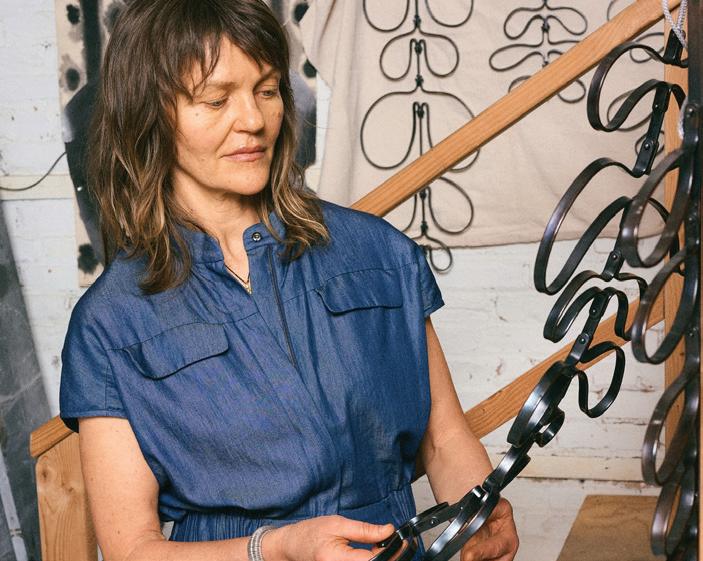
Where: LongHouse Reserve, East Hampton
When: Through December
Why It’s Worth a Look: Here, Jill Platner transforms the Dawn Redwood Forest canopy into a living gallery, turning the vibrant landscape into an even more dynamic ecosystem of brush, undergrowth, and metallic forms. The artist invites viewers to witness her suspended, handcrafted copper sculptures among the trees.
Know Before You Go: There are more than 60 works subtly nestled in the tree branches, so be sure to keep a lookout for the varied silhouettes rustling in the breeze.
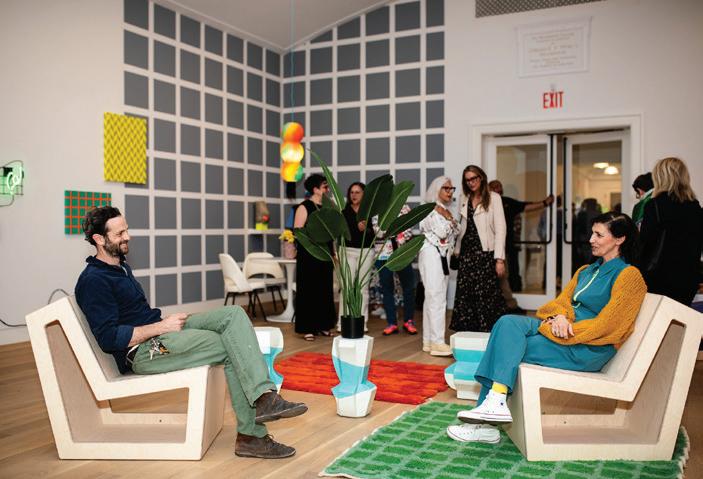
Where: Guild Hall, East Hampton
FROM THE UNEXPECTED ICONOGRAPHY OF BIBLICAL SAINTS TO LOUISE BOURGEOIS’S SPRAWLING SPIDERS, THE EAST END’S ART CALENDAR OFFERS A LUSH VISUAL FEAST THIS SEASON.
Where: The Parrish Art Museum, Southampton
When: Through Sept. 1
Why It’s Worth a Look: Shirin Neshat, an Iranian-born artist and filmmaker living in exile in New York, offers a non-linear survey of her major series. These range from an early foray into photography, “Women of Allah,” 1993–97, to her 2019 exploration of American culture, “Land of Dreams.”
Know Before You Go: This is the artist’s first museum showing in the New York area in over two decades, and includes pieces from her personal collection— featuring works by Marina Abramović, Robert Longo, and more.
When: Through July 13
Why It’s Worth a Look: Almond Zigmund, known for her site-responsive installations and bold geometric forms, has transformed Guild Hall into an immersive “Wading Room.” Unlike in the East Hampton institution’s other galleries, visitors are invited to sit, stand on, and enjoy the artist-made furniture and objects spread throughout the space.
Know Before You Go: The room was arranged in conjunction with Guild Hall’s “Functional Relationships: Artist-Made Furniture” exhibition, which features pieces crafted by John Chamberlain, Mary Heilmann, Donald Judd, Julian Schnabel, and, of course, Zigmund.

Where: Pollock-Krasner House and Study Center, Springs
When: Through July 12
Why It’s Worth a Look: This exhibition offers an intimate look into the eclectic oeuvre of Rosalyn Drexler, whose work spans plays, novels, painting, music, and even pro wrestling.
Know Before You Go: Here, the curator narrows in on Drexler’s vision of the domestic space: Is the home a place one escapes to, or from? The 98-yearold artist dives headfirst into the tension between joy and conflict often present in mid-20th-century family spaces.

Where: The Church, Sag Harbor
When: Through Sept. 1
Why It’s Worth a Look: This choral show, curated by co-founder Eric Fischl, encourages viewers to think about the Great Flood—a legend of destruction, cleansing, and rebirth. Aptly, the show is composed of animal sculptures by more than 40 international artists (Jaune Quick-to-See Smith, Rosemarie Trockel, and William Kentridge among them) working in the last century, providing a comprehensive overview of humans’ relationship with animals, the self, and the natural world.
Know Before You Go: Stop by on a pleasant day, since this exhibition marks the first time the Church will use its outdoor deck on the mezzanine, where they will be displaying Louise Bourgeois’s Spider Couple, 2003—a spindly, eightlegged, 12-foot sculpture.

Where: Hesse Flatow, Amagansett
When: Through July 26
Why It’s Worth a Look: This group show combines an expansive array of works across 33 artists in a rather peculiar venue: a 4,000-square-foot former potato barn. Curated by writer Andrew Gardner and artist Emma Safir, the show features talents such as Liz Collins and Martine Gutierrez, who have come together to honor the biblical patron saint of images, photographers, linen weavers, and laundry workers: St. Veronica.
Know Before You Go: To mark the exhibition’s closing, choreographer and performer Jack Ferver will conduct an on-site activation of the space entitled It’s Veronique.
“INDEPENDENCY:

Where: Southampton Arts Center
When: Through July 19
Why It’s Worth a Look: The show marks a significant anniversary with memorabilia from the private collection of American History Unbound creator John Monsky. Along with co-curator Christina Strassfield, the lifelong flag collector offers an exploration of the iconic American symbol’s legacy, juxtaposed with a selection of paintings by artist Sean Scully.
Know Before You Go: Highlights of this show include a 1775 George Washington kerchief, a flag for the candidacy of “Abram” Lincoln, and banners from the Apollo missions.
“MY

Where: The Arts Center at Duck Creek, East Hampton
When: Through July 20
Why It’s Worth a Look: A poignant portrait of queer love, these works depict an unvarnished view of intimacy as seen through the eyes of artist and filmmaker Carol Saft. The paintings center on her partner Cynthia in states of rest, ritual, and vulnerability—allowing viewers a unique entry point into the couple’s domesticity in a very public arena.
Know Before You Go: Each moment is framed with a filmmaker’s precision. Often set in the bedroom or bathroom, Cynthia appears with a towel draped over her shoulder, or with the glow of an LED mask distorting the face.
“WOLFGANG

Where: Peter Marino Art Foundation, Southampton
When: Through Sept. 27
Why It’s Worth a Look: While all of the 90 Wolfgang Tillmans works on view are pulled from Peter Marino’s personal collection, the artist curated and designed the installation himself—selecting the placement of pieces and the rhythm of the show. This provides an intimate portrait of the artist as seen through the eyes of a passionate collector.
Know Before You Go: Also on view this summer are “Vienna 1900 Art & Decoration,” highlighting pieces from the Wiener Werkstätte, and “Andy Warhol – 15 Minutes of Collecting,” composed of 30 screen prints, drawings, and photographs.

Where: Harper’s Gallery, East Hampton
When: July 5–Aug. 13
Why It’s Worth a Look: Genieve Figgis’s first solo show with the gallery since 2016 sees the Irish artist imbuing borrowed historical mise-en-scènes with her signature jolt of humor. Traditionally stuffy environments become funhouses where the grotesque and macabre collide.
Know Before You Go: Take note of Figgis’s distinctive method of pouring paint directly on the canvas, then manipulating it into her preferred shapes and figures.

Where: Water Mill Center, Southampton
When: Through Feb. 15, 2026
Why It’s Worth a Look: Curated by artist Brian Belotti and Watermill’s Noah Khoshbin, this exhibition of 400 pieces from the Rhoda Kellogg International Child Art Collection promises a fascinating array of children’s graphic expressions and responses from over 35 contemporary artists. Those digging into the archive include Katherine Bernhardt, Jamian Juliano-Villani, Christopher Wool, and Joe Bradley.
Know Before You Go: Two major outdoor installations on the property will also be unveiled just in time for Watermill’s annual Summer Benefit on July 26: Abetare by Petrit Halilaj, originally commissioned last year for the Met’s Roof Garden Commission, and SUNRISE.East, 2005, by Ugo Rondinone.
SANDY AND STEPHEN PERLBINDER’S TIES TO THE EAST END AND ITS ARTIST COMMUNITY GO BACK FIVE DECADES, A NEARLY LIFELONG COMMITMENT THAT THE PARRISH WILL CELEBRATE THIS JULY.
BY KARLY QUADROS
AND STEPHEN Perlbinder have been part of the cultural fabric of Long Island’s East End since 1969, when the young couple, still in their 20s, commissioned an oceanfront home from soon-to-be starchitect Norman Jaffe. Through the years, the Sagaponack residence has weathered its share of renovations, expansions, and relocations due to the elements (fires, floods, and beach erosion among them) and their own growing family’s needs. One constant has been the art collection that fills its walls: a trove of works by Jack Pierson, Almond Zigmund, Constantino Nivola, Roni Horn, Jenny Holzer, and more.
The couple has also worked extensively with the Parrish Art Museum, beginning with support for a Jaffe retrospective in 2005, and with Sandy now serving as vice president of the board of trustees. This July, the couple will be honored at the museum’s annual midsummer gala for their work. Ahead of the event, the Perlbinders reflect on their collection and the community that has shaped it.
Which work in your home provokes the most conversation from visitors?
A Jenny Holzer granite bench greets guests at our front door with the phrase “HAVING TWO OR THREE PEOPLE IN LOVE WITH YOU IS LIKE MONEY IN THE BANK” carved on the seat. The phrase, from Holzer’s “Living” series, sets a tone of comfort for us when we walk in the door. As you climb the stairs to the living room, you see the Sagaponack dunes stretched in front of you through the tall glass windows. Soon after, your view turns to a large Cape Cod dunescape in acrylic on canvas— Passing Time, 2000, by Jack Pierson—mirroring the nature in the background.
How has the local art scene influenced your collection?
We’ve met many wonderful artists together, many of whom have shown at the Parrish, like Keith Sonnier and Mel Kendrick, whose works we first encountered in local galleries and are now part of our collection. Several of the artists that we’ve come to know have engaged [Stephen] to help with their projects. In the summer of 1970, Dennis

“WHAT WE LOVE ABOUT THE LOCAL ART SCENE ON THE EAST END IS THAT, YES, IT IS FRESH AND EXCITING, BUT IT’S ALSO VERY ACCESSIBLE.”
Oppenheim asked Steve to fly him at dusk in Steve’s twin-engine Beechcraft Baron over fields in Bridgehampton where Dennis had installed thousands of candles arranged in two shapes for his conceptual piece Polarities. We have an early version of this work in our collection.
What we love about the local art scene on the East End is that, yes, it is fresh and exciting, but it’s also very accessible. One day we might find ourselves exploring a high-end New York gallery that has decamped here for the summer; the next we’re visiting an artist working from the Duck Creek barn or at a historic site like the Pollock-Krasner House and Study Center.
How has your collection changed as your home and space has changed?
The gorgeous sunlight on the East End is why we are all here, but it can be a curse for a collector. We have had to rethink where we hang anything on paper. Sculptures and oils are a big part of our collection.
Which artist are you currently most excited about and why?
We are always excited about the last piece we’ve acquired—the most recent is a Claude Lawrence oil. A prominent local artist and jazz musician who lives in Sag Harbor, Claude has rekindled the Abstract Expressionist spirit in a fascinating way. When you walk by his painting [in our
home], you see a visual expression of jazz improvisation.
What are three must-see shows in the Hamptons this summer?
The Parrish Art Museum exhibitions are always a must-see. Both “Shirin Neshat: Born of Fire” and “Sean Scully: The Albee Barn, Montauk” are so well done and leave you with a lot to think about. Next, we’re going to check out John Torreano at the Drawing Room in East Hampton. At this time of year, we love seeing the local gardens, especially at Madoo, and the outdoor sculptures at LongHouse Reserve.
What is the strangest negotiation you’ve ever had with an artist or dealer?
It wasn’t strange, but it is regrettable. Our first art dealer, James Goodman, offered us two small Jackson Pollocks in the ’60s. The pieces were above our budget—but looking back, what a miss!

AS YOU MIGHT HAVE GUESSED, MOST OF LARRY GAGOSIAN’S PICKS ARE ABOUT ART. BUT THE NEWLY MINTED BOOKSELLER HAS A FEW SURPRISES UP HIS SLEEVE.
LARRY GAGOSIAN MAY BE known as the world’s most famous art dealer, but he recently took on another title: bookseller. After the original owner of BookHampton put the beloved East Hampton bookshop up for sale last fall, locals feared a new buyer might shutter it. Then along came Gagosian, a longtime Amagansett resident, who swooped in to purchase the business in May. He says he plans to stay the course and maintain the establishment’s vibrancy as a community hub, though he can’t resist expanding its art and design offerings.
To inaugurate “Required Reading,” CULTURED’s new column in which influential tastemakers reveal what’s on their nightstands, Gagosian shared his literary habits—and his surprising personal connection to one of the hottest novels in recent East End history.

Where’s your favorite place and time to read?
I mostly read in the evenings—wherever I am. I also travel a fair amount and like to read when I’m on the plane.

You just bought a bookstore in East Hampton. What’s your favorite thing about shopping in person?
BookHampton is a great place to buy books. As a pretty consistent reader, bookstores are genuinely useful to me—I like picking things up, reading the dust jackets. I order online sometimes, but the great thing about a bookstore is that you’ll go in looking for one thing and come out with five. There’s no substitute for that kind of experience.
For me, the ability to browse is key. Sometimes a title or author will intrigue me, but when I read a few paragraphs, the prose might not land—I realize I wouldn’t want to spend 300 pages with that voice. That kind of spontaneous sampling can only happen in person.
What is the future of BookHampton?
I have lived in Amagansett for 35 years, and I’ve always loved the fact that Main Street had a wonderful independent bookstore. It will remain a general interest bookstore, but I plan to bolster the art and design offerings. I want to ensure that it remains relevant, and East Hampton is a
community with a lot of people who care about art.
Name one book you recommend to anyone who spends time in the East End. I’d like to give Emma Cline a shout-out for The Guest. She wrote it while staying in my guesthouse.
Who’s an artist you feel deserves a biography but doesn’t have one yet?
There are a lot of artists who deserve a biography. In terms of more recent artists, I think Richard Prince deserves one.
One book your childhood self loved? Black Beauty. I remember being captivated by that book.
One book that made you want to live your life in a certain way?
I don’t know that any book ever changed my life. I like biographies, and I loved Walter Isaacson’s biography of Steve Jobs in particular. It was a testament not only to a vision, but to the power of incredible tenacity. That book made a big impression on me.

MARIA MCMANUS DESIGNS CLOTHES WITH EASE AND SPONTANEITY IN MIND. THE MONTAUK LOCAL APPLIES THE SAME RULES TO HER SUMMERS OUT EAST.
In fashion circles, Maria McManus is known for refined tailoring and environmentally conscious luxury pieces. In Montauk circles, she’s known for throwing a memorable summer dinner party.
After years of seasonal pilgrimages, the Dublin-born, New York–based designer put down roots out East a little over a decade ago, embarking on an ambitious renovation that transformed a double A-frame house into a sleek, airy beach haven. “We bring everyone together: kids, adults, grandparents, all around our oversized outdoor table,” McManus says. “I try to emulate that casual feeling back in the city.” As the designer settled in for a summer of long outdoor evenings, she shared a few of her favorite aspects of Hamptons life with CULTURED.
Describe your perfect day in the Hamptons.
Irish tea on our back deck listening to the ocean, followed by a beach walk. Family lunch at Carissa’s (this would likely include their vegetarian Reuben sandwich and hibiscus iced tea). A walk through LongHouse Reserve. I love to see the seasonal changes in each of the gardens there. My husband is a really great cook, so the day would end with a homemade meal surrounded by local friends.
Tell us about your Hamptons uniform. I’m always reaching for our A-line Shirt in either Portuguese organic linen or cotton, depending on the day. It pairs perfectly with our Bow Leg Jean, crafted from organic Japanese denim that’s perfect for the summer months, and a pair of Birkenstocks.
What do you do to feel grounded? Gardening, or walking by the ocean.
Tell us about your home and the renovation. What are the pieces that mean the most to you there? We bought our house almost 12 years
ago when our second daughter was a tiny baby. We wanted to move beyond summer rentals. I love a renovation—my husband and I have done many together over the years. We came across a double A-frame house in Dutch Plains, built in 1982, and we saw the potential right away. It had lots of lovely original charm—a spiral staircase, an oversized hallway—but was not quite right for a beach house. We worked with our old friend and incredible architect Thomas Ryan on the redesign, which was a collaborative process from start to finish. We took inspiration from the Parrish Museum and kept materials
“I love the summer months here because the bees, butterflies, and birds have finally returned.”
—MARIA MCMANUS
simple: whitewashed wood, concrete floors, unpolished brass, and lots of large windows to bring in natural light. The staircase is particularly special; it has a large picture window at the bottom and a beautiful skylight at the top. One of my favorite details is the unpolished brass handrail, which was custom-made by a metal worker here in the Hamptons. When we furnished the house, we only sourced vintage pieces like the Percival Lafer sofa and a 1970s green marble coffee table. If vintage didn’t work, we looked to incredible local designers, like Sawkille Co., who created our walnut dining table.
What’s your greatest seasonal indulgence while in the Hamptons?
A boat trip to Shelter Island with my girlfriends.
What are your rituals for more sustainable
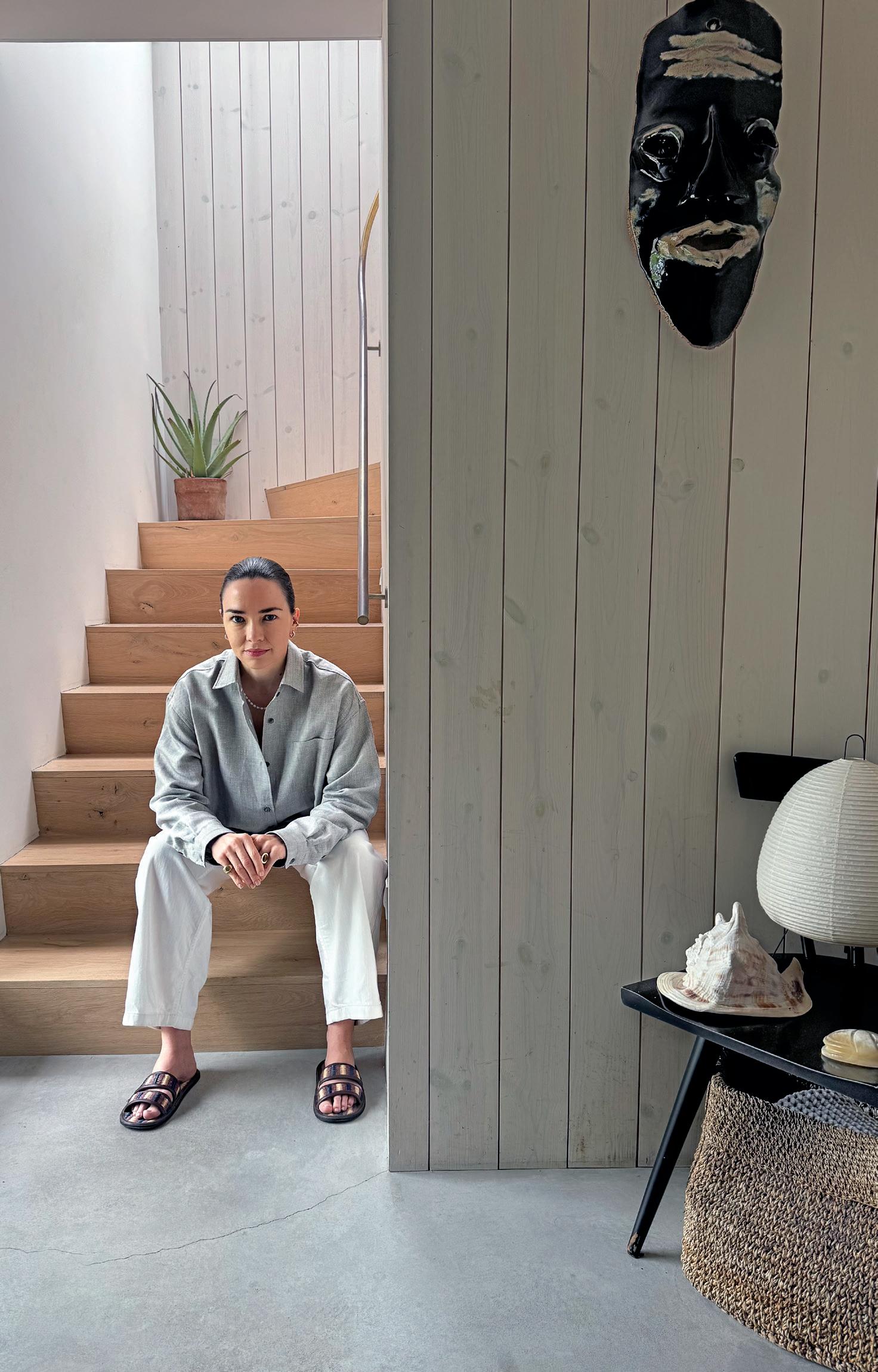
living? Any specific to the Hamptons?
We drive an electric car out East or take the train. Having a back garden is such a novelty—we compost everything here. I love the summer months here because the bees, butterflies, and birds have finally returned. The entire garden is drought-resistant or native plants, and we use no pesticides, weed killers, or fertilizers. We are also trying to maintain plastic-free bathrooms using brands like Vintner’s Daughter skin care, Blueland cleaning products, Sándor Earth hair care, and Singular Care toothbrushes.
How does your life in the Hamptons inspire your city life? Vice-versa? We cook for friends a lot out here. We bring everyone together: kids, adults, grandparents, all around our oversized outdoor table. I try to emulate that casual feeling back in the city when we host dinner parties.
How does your life in the Hamptons inspire your collections? Being in Montauk brings an ease and casual feel to the collections. Simple
in natural materials mirror the relaxed nature of life out here. I’ve also learned the importance of playing with layering and how this level of functionality can still feel well-designed.
What are your favorite spots out East— shops, restaurants, etc.
Valentina Akerman has a gorgeous eye, so we always stop by Galerie Sardine.
My friend Sheila Bouttier of Galerie Provenance shows her collection of European mid-century design furniture in Bridgehampton every summer, which is always something to look forward to. The Crow’s Nest has a solid policy where they seat locals first, so we have many a family dinner there. Balsam Farms has a gorgeous farm stand in Montauk where we get all our produce. The Cowboy Candy pickles are a family favorite. For shopping, Amagansett is the greatest. Love Eats for food, Love Adorned for gifts, La Garçonne for clothes, E-E Home for beautiful homeware, Nellie’s for vintage, and Missi for the most incredible bouquets.
BY MARA VEITCH
Amy Sillman’s New York studio is a place of action—all kinds. “I’m a big studio rat; I go all the time and I stay for a long time,” says the 69-year-old artist, who moved to the city in 1975. The action in question begins with the usual “normcore” stuff— caffeinating, tidying, reading emails—and escalates to a creative fever pitch that involves “cutting, collaging, transferring, hauling things back and forth, turning things up and down, painting over, erasing, stripping, napping, talking on the phone, reading, getting more emails, walking my dog, [and] making more coffee.” It’s an entire life’s worth of tasks crammed into the confines of a day.
At the time of our interview, Sillman isn’t in her studio—she’s out at her place on Long Island’s North Fork, not far from where she’ll open “Alternate Side (Permutations #1–32),” a show of new works at Dia Bridgehampton, on June 28. She’s in the middle of a lengthy back-andforth with her handyman, who is there to paint the halls.
Sillman apologizes for the disruption— but these, it’s become clear, are part of her process. Last September, at the Kunstmuseum Bern, the artist opened “Oh, Clock!,” her first institutional survey in Europe in collaboration with the Ludwig Forum Aachen, where her work is still on view through Aug. 31. She categorizes these shows as “them on me”—a twopart undertaking where half the show is dedicated to her work, and the other half offers a Sillman-curated selection from the institutions’ collections hung on gallery walls that the artist decided to paint on a whim. “It was not what they were expecting,” Sillman says of the improvised action. “I did the whole thing off the top of my head.”

with recombinant linear elements that are assembled differently on every sheet, never repeated. They were all one-offs. I would make handmade grounds on paper, then silkscreen, wash, silkscreen, wash, draw over, silkscreen over that, repeating the elements in different combinations.
The wall work must be wild, open, and free. It might be incoherent, or kind of strange. I want [the show] to feel like cooked on raw—fried egg on salad or something.
Do you consider this work to be in dialogue with other artists associated with Dia institutions?
Yeah, I’ve thought about how Dan Flavin is upstairs, and about Dia as a place that sponsored works like Michael Heizer’s “hole in the ground,” [Robert] Smithson’s piles with mirrors in them, or Richard Serra’s black and white walls. I thought a lot about the recombinant, minimalist process of iteration here. Flavin’s work is about light; he lights the wall like the ground of a painting. There is no figure except the light bulb, which is a tube, not dissimilar to these weird linear forms that I’m bending.
Are you surprised to find yourself in dialogue with those artists?
In the weeks leading up to the show, Sillman is making regular pilgrimages to Dia Bridgehampton. The silkscreened works are ready to be hung, but the wall work that will form their backdrop remains a mystery. “I’m having bad dreams about squeezing out of parking spaces,” she says of the impending project. “I have no idea what I’m doing. It’s really scary and really fun.”
Here, Sillman takes a moment to reflect on the headspace that got her there.
What’s in your studio fridge?
Milk and water. I have a tiny fridge, only because my former summer subletter insisted on it. It’s one of those little bitty ones. It doesn’t fit very much.
Sillman sees the experiment as a success. The Dia show will be “me on me”—she’ll paint the gallery walls and present her series of recently completed silkscreen and painted works on top of them. “I thought of them like Sol LeWitts—line forms that repeat, just not in a very structured or legible way,” she says of the works, which feature her signature method of addition and erasure, but newly systematized. “They’re based on a set of terms, like a grammar, a tidy closed circuit.”
What rules do you have for yourself when you’re in your studio?
There are no rules, other than that I’m alone. No sound, no music.
Two of your recent exhibitions—at the Ludwig Forum and the Kunstmuseum in Bern—featured new work alongside work curated from the institutions’ collections.
For the Dia show, you’re presenting entirely new works. What made you abandon your previous approach for this exhibition?
In both of those museum shows, half the space offered a focused look at my work. For the other half, I curated their collection and painted the walls. It started in Bern, and it was not what they were expecting. I was a little light-handed because I wasn’t sure what I was doing, and I did it all off the top of my head. When I got to Aachen, I was like, That was great, I’m going to go for it again. I ramped it up by a factor of 20—I built huge walls on wheels that I painted on and situated throughout the gallery.
And this show?
This show is “me on me” instead of “them on me.” I’m still going to paint the walls, but I’m pairing that with my own work. It’s going to be improv—I literally don’t know what I’m going to paint yet.
Can you describe the difference in headspaces between creating a show that is, as you say, “them on you,” and one that’s “you on you”?
I won’t know until I complete the process by painting the walls. The work I made to hang on them is this series of silkscreens
I was surprised at first by this conversation I’m having with what might be called minimalism. Around the pandemic, I realized the problem with my way of working: It’s agonistic. I never know when I’m done—I’m always tearing out my hair; it never ends. So I thought, What if, like a minimalist, I had a system or a process? When the process is complete, the painting’s over.
How would you articulate that system, if you had one?
I think it would be gesture, erasure, gesture, erasure, gesture, erasure, print, reprint, reprint, wash, reprint, wash, gesture, reprint, wash, print.
When it comes to the work you’ll create on site, you say you’ve got some ideas, but you don’t know how it will come together. How does that feel?
It’s terrifying. I’m having bad dreams about squeezing out of parking spaces. When I was speaking with the Dia curators a few weeks back, one of them said, “Hold on, I gotta move my car.” I was like, “That’s the title of my show—‘Alternate Side.’” It’s as hard to find a parking space in New York as it is to make an abstract painting. I love the idea that the problem is the provocation, and the work is the response to that disruption.
THE KYIV-BORN ARTIST HAS SPENT MUCH OF HER LIFE IN MOTION. WHEN SHE FIRST DISCOVERED THE LONG ISLAND TOWN, SHE FELT A SENSE OF HOME AGAIN.
BY JACOBA URIST
PHOTOGRAPHY BY LEO PEREZ
“SHELTER ISLAND REMINDS me of my childhood,” says artist Zoya Cherkassky. It’s a surprising comparison at first. The low-key, Hamptons-adjacent enclave, accessible only by ferry, would seem to be worlds away from the Ukrainian villages of her youth. But, she insists, “the landscape is more familiar than where I have been for so long.”
Born in Kyiv, the 49-year-old painter immigrated from Ukraine to Israel in 1991, where she lived until Oct. 7, 2023. Soon after, Cherkassky relocated to Berlin with her young daughter. It was a year later, during a brief stay with her gallerists, Fort Gansevoort co-founders Adam Shopkorn and Carolyn Tate Angel, that she discovered Shelter Island, where the artist now has a permanent studio. When we meet, she has only been there for a month and a half—but it already feels transcendent. “It’s not like I chose Shelter Island—the island chose me,” she says.
Within days of the attacks in Israel and ensuing war, Cherkassky turned to colored pencils in Berlin—having brought only basic art supplies—as a response to the terror. She posted a few of the initial works on Instagram: a haunting composition of a family, three generations hiding in their safe room, the mother clamping her hand over her infant’s mouth to prevent noise. Two months later, the Jewish Museum in New York mounted an exhibition of the

series: “October 7th, 2023.” A dozen of Cherkassky’s drawings portraying kidnapped women, burning houses, and dead bodies occupied a small, black-walled room. Calling on historical depictions of anguish, from Munch’s The Scream to Picasso’s Guernica, Cherkassky revealed the fresh horrors of war.
That wasn’t the first time she had captured the atrocities that have become indissociable from the fabric of her adopted home. One example is her 2023 canvas After Pogrom, which depicts a Palestinian family in front of their burning home in the West Bank town of Huwara, torched by Israeli settlers that same year.
Her latest work, moody twilight scenes and fiery dusk skies created on Shelter Island, offers a sharp juxtaposition to what came before—and a moment of tranquility. “Oh my God,” she laughs. “What happened to me? I don’t recognize myself. I was always a political artist, and now suddenly I’m making sunsets. I’m just letting myself explore this new place.” As the summer seeps in, Cherkassky, who tends to gravitate toward oil on canvas and acrylic or watercolor on paper, is “planning to go plein air big time.” She’s looking forward to loading her equipment into her small Jeep and setting up in the fields and farmland of the North Fork. Of her radical shift in subject matter, the artist says, “It’s a process of healing.”


OFFERS A LOVING TRIBUTE TO MONTAUK’S DITCH PLAINS BEACH.
BY GIULIANA BRIDA

There’s something about a beach that suspends reality: Strangers become neighbors, politics shrink beneath umbrellas, and the only performance required is presence. In Nat Ward’s latest book, Ditch: Montauk, NY 11954, the photographer turns his lens on the Hamptons hamlet’s Ditch Plains Beach—not to romanticize its surfsoaked iconography, but to expose its peculiar gravity. The project, born on a whim during a residency at the Edward F. Albee Foundation, unfolded over four summers as Ward returned again and again, panoramic camera under his arm, to capture the human drama that unfurled across towels and tide lines. CULTURED spoke with Ward about the genesis of the book, the politics of shared space, and the characters who make Ditch Plains a crucible of American contradictions.
How did this project begin?
I was a resident at the Edward F. Albee Foundation, the Barn in Montauk, in 2018. I had purchased this very unique camera—a medium format panoramic camera. It’s a nerd camera that spawned
“Those interactions at the beach were a restoration of faith.”
—NAT WARD
a million Flickr accounts of people taking pictures of sunsets with perfectly aligned horizons. At the time, I had long hair and a big beard—I was a bit of a peacock. Between the camera attracting attention and engaging with people, I became really interested in the fact that Ditch Plains is very much like the beaches I grew up going to on the Jersey Shore—crowded, full of potential relationships. It becomes a vibrant, diverse community in the summertime.
What kept drawing you back?
It has to do with my own reaction to the social and political moment. Man, I was stressed out. It was chaotic and fractious—and still is, although I’m managing it better now personally. In 2018, 2019... I had to break up what almost became a physical fight in a college classroom while I was being
observed teaching [at FIT]. It had nothing to do with what I was saying—it was just that everybody was ready to go after everybody at the drop of a hat. Those interactions at the beach were a restoration of faith. From a data-based perspective, I had nothing in common with most of the people I met there.
Is there a particular person who comes to mind?
There was this woman who would come to the beach with her red MAGA hat every single day. She was the only person nobody talked to. So I went up to her. I know she was looking to talk politics— that’s why she wore the hat—but I didn’t want to talk about that. I wanted to know where she was from, what her family was doing. She was a grandma from Suffolk County. Hearing about what her grandkids were up to was much more interesting
than talking about social strife or the breakdown of our political system.
Did you share the images you made with your subjects?
Oh, yes. But months afterwards, because I’m slow. People were psyched. I know it’s silly, but the radical position of saying, “Let’s go out and have some fun talking with strangers,” in this moment where you can’t even talk to your uncle... I’m so moved by that idea.
What was the most memorable discovery you made at Ditch Plains?
I found the level of honesty—the physical performance or lack thereof—generated so many discoveries for me. On the masculinity spectrum, there’s a photograph of a young man. He was stunning and he knew it. I loved that particular combination: the charisma of knowing how desirable you are and being willing to present that in public for a photographer... I mean, how do you say no to that? Other men just could not care less. I’d be like, “Can I make a picture?” and they’d say, “Yeah, whatever. Go ahead.”
HERE ARE THE NINE CAN’T-MISS POP-UP SPOTS TO ADD TO YOUR SUMMER ITINERARY OUT EAST (PLUS A FEW OTHER HAPPENINGS WE’VE GOT OUR EYE ON).

At the Hedges Inn, shopping Chanel’s pop-up salon is as much a relaxation exercise as it is a chance to peruse the house’s latest designs. The bed and breakfast has provided a lounge, two fitting rooms, and an outdoor terrace, all bursting with the French maison’s 2025 Ready-to-Wear, Coco Beach, Métiers d’Art, and Pre-Fall collections, as well as a selection of handbags, shoes, accessories, watches, and fine jewelry. Through July 28

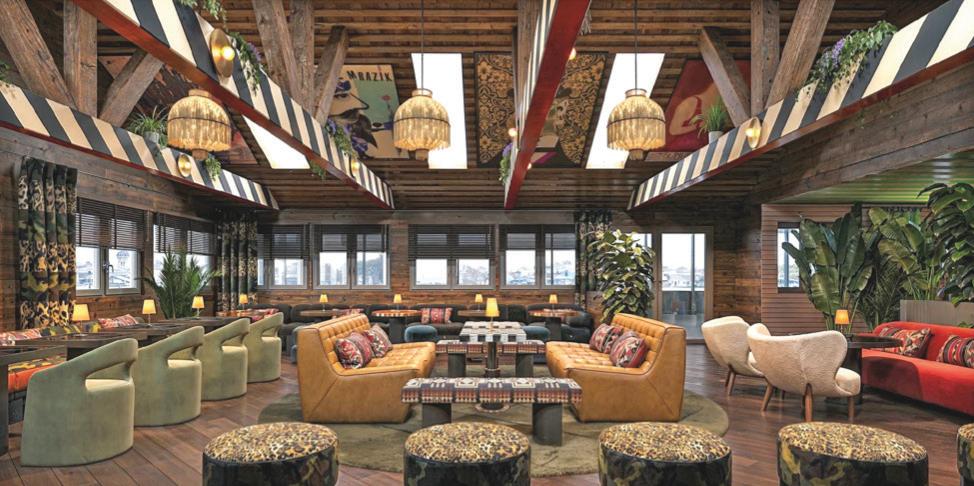
update with eclectic design, oceanfront views, and elevated dishes. Michael Jordan, Venus
Williams, and more were fans of the Floridian interpretation, and a similarly enviable crowd is sure to make use of this East End outpost—where dining gives way to dancing after dark.
Would it be summer in the Hamptons without Joel Mesler? The local artist has partnered with French swimwear brand Vilebrequin on a capsule collection featuring swim trunks and a tote bag
adorned with his signature beach balls and balloons. The launch precedes his “Miles of Smiles” exhibition opening at Guild Hall this August. We dare you to show up in your swim trunks.
This summer, the Giorgio Armani Mare tour will complete its coastal sojourn in the Hamptons with a final stop on Shelter Island. The pop-up is adorned in tropical palm patterns and surfboards, and ice cream carts abound. Visitors will shop the latest from the Giorgio Armani Mare
line, featuring light, flowing silhouettes in a white, ecru, and black palette. For the third year, the house is also directing proceeds to support the One Ocean Foundation, dedicated to the preservation of marine life.

Nineteen cabins. One coast. Two guests? Ruschmeyers’s laid-back grounds turn romantic as the sun sets and warm lantern light fills the boutique hotel’s Grill. Helmed by Chef Jordan Heissenberger, the restaurant

You’ve never seen an art space like this before. Spread across two locations in Sag Harbor, Lauren Shooster’s new living gallery features over 300 pieces of fine art, antiques, and rare books— including pulls from Pablo Picasso,
Your local purveyor of Aussie style is reopening in Southampton. In 2022, the Sydney-born house debuted its second Hamptons outpost in an 1898 bank restored to near-original condition. The rich, wood interiors and security vaults are complemented by vintage design pieces—including a 1940s Fritz Hansen armchair and a Willy Van Der Meeren wardrobe. This season, it’s a must-visit for those seeking fashion and design staples alike.
Allen Ginsberg, Jenny Holzer, and Josef Albers. The first location is a traditional whaler’s cottage from the 1840s, while the second is a ship-chandlery building dating back to 1850.

serves up oysters, clams, and more coastal fare before guests retire to the Lounge for craft cocktails and a curated soundtrack. The next morning, recline in a sun-drenched hammock before doing it all again.

Nestled in the Maidstone, Sézane has built a portal to Paris. The brand is bringing its Amour Tour, a series of pop-ups around the world, to the East End. At the historic East Hampton hotel, visitors will
be able to shop a selection of Sézane’s bestsellers and accessories, including the Justine basket bag—a sloped carryall designed with beach days in mind. Through July 27

You loved it in New York; now reacquaint yourself with the buzzy restaurant in the Hamptons. After a Palm Beach run, Swifty’s is popping up in the Hamptons for the first time at the Hedges Inn. The 100 indoor and outdoor seats ensure this will be a bustling spot all summer long—serving local seafood, freshly baked bread, and wine from the nearby Wölffer Estate. If you’re hoping to catch a weekend brunch res, act fast.
THIS SUMMER, THE REVERED ARTIST AND SAG HARBOR LOCAL WILL BE HONORED BY HIS HOMETOWN INSTITUTION OUT EAST. BEFORE THE FESTIVITIES KICKED OFF, HE TOOK A MOMENT FOR SOME SUMMERTIME REFLECTION.
BY JACOBA URIST
PHOTOGRAPHY
BY LEO PEREZ
AT 54, SANFORD BIGGERS is already an elder statesman in the art world. The Los Angeles–born polymath describes his process as “conceptual patchworking,” finding inspiration in sources both material and conceptual— from recycled quilts, African masks, and classic European sculpture to hip hop and Afrofuturism.
In July, the Parrish Museum will honor the artist, who is based between New York and Sag Harbor, at the institution’s annual Midsummer Gala in anticipation of a solo exhibition, opening next summer, organized by Chief Curator Corinne Erni. “At the Parrish, we work with artists who have a deep connection to the East End of Long Island, or who are in meaningful dialogue with the art historical relevance of this place,” says Parrish Executive Director Mónica Ramírez-Montagut. Biggers, undeniably, embodies both.
CULTURED’s Hamptons Editor Jacoba Urist caught up with the artist at his Bronx studio for a discussion about the summer’s festivities before he decamped out East.
Each of the Hamptons has its own character. How did you choose Sag Harbor? Sag Harbor was a middle-class Black enclave for several generations. I grew up in a similar type of neighborhood— although much larger—in Los Angeles, called Baldwin Hills. The village in Sag Harbor is one of our favorite places to walk around. We visit the cafes, the bookstore, and the Church and galleries to see art. The Hamptons encompass many different vibes—worlds within worlds. I like the flavor of Sag Harbor because it feels a little more low-key, small-town.
What makes the Parrish Museum a unique place to see art?
I love the architecture. My kids enjoy the museum too. There’s the height of the building, the skylights. You experience its beauty just from driving by. I like visiting when it’s gray and rainy—it gets misty, and you can see the fog over the landscape. I’m incredibly excited to be honored by the Parrish this summer. It’s particularly gratifying to be recognized in your hometown. I’m thrilled to be embraced by this part of my life.
Your use of antique quilts in contemporary art is legendary. What inspired you to use these found textiles? A lot of my projects start with historical research—incongruities and inconsistencies, strange or awkward moments in history that spark an idea. Years ago, I learned that quilts were used along the Underground Railroad as signposts. Historians have debated whether this is true, but the idea was that
a quilt hung in a certain way or showing a particular pattern contained a code that enslaved people would be able to read. I soon found myself using my mediocre sewing skills to repair quilts and create new canvases from them. I then use materials on top of them, like spray paint, oil, acrylic, tar, and glitter—and of course other textiles—to make elaborate paintings and drawings.
I used to do graffiti growing up in Los Angeles. Working on these quilts, I’m struck by a tension: Am I beautifying these artifacts, or am I desecrating them? Am I making them better, or am I disregarding what came before? It’s like sampling—a song from when you were a kid that disappeared until some rapper or pop star sampled it. Now, it’s the biggest song on the radio. Is that good or bad? For me, it’s about the intention.


“WORKING ON THESE QUILTS, I’M STRUCK BY A TENSION: AM I BEAUTIFYING THESE ARTIFACTS, OR AM I DESECRATING THEM? AM I MAKING THEM BETTER, OR AM I DISREGARDING WHAT CAME BEFORE? … FOR ME, IT’S ABOUT THE INTENTION.”
—SANFORD BIGGERS

ON THE HEELS OF THE RELEASE OF HER FICTIONAL DEBUT, TINX IS JOINED BY FELLOW AUTHOR SARAH HOOVER FOR A CANDID CONVERSATION ABOUT MODERN WOMANHOOD.
Armpit Botox, postpartum depression, extramarital fantasies—nothing is off the table when Tinx and Sarah Hoover sit down for lunch. Both “Page Six” fixtures released books this year that explore the inner lives of women and push against the societal expectations that seek to constrain them. First, Hoover dropped The Motherload, a memoir about developing, diagnosing, and emerging from postpartum depression. Then, last month, Tinx, known to her followers as “TikTok’s older sister,” released Hotter in the Hamptons, her fiction debut about a rivalry between two women who share a fence out East. Ahead of its release, they connected for a fittingly no-holds-barred midday catch-up.
SARAH HOOVER: You have a fucking book coming out, girl.
TINX: You just had a book come out. We’re just two bookie gals.
HOOVER: We know the pain, and the glory—so much glory. You’re going to [California]. I love to see a girl get what she wants in life. Here’s my problem: I sweat a lot, especially in direct sunlight.
TINX: I’m sweating a lot lately because I tried a new birth control. Have you ever
done Botox in your armpits? Does it work?
HOOVER: It makes you not sweat, but you still smell, which is weird. First of all, it really hurts. It’s not just three little pricks in your forehead. Who knew armpits were sensitive? It lasts for four months or whatever. I’m like, Well this isn’t worth it Armpit sweat isn’t actually my problem. It’s the fact that sweat is running down my thighs and down my forehead in public. My goddaughter—who’s the most beautiful, perfect, 24-year-old, coolest angel on the planet—is Italian, and she’s baking in the 100-degree sun in Corsica and would not have a drop of sweat on her ever. It’s so cool to be that pretty.
TINX: I love those girls. Those girls are the truth, man.
HOOVER: It’s a different kind of human. That’s just not me. I was trying to remember how we met and I truly cannot.
TINX: It’s killing me that we can’t remember. I feel like maybe it was in Paris… Let’s just say we met in Paris because that feels very us and very fun. We both really care about women, and we both really care about opening up conversations by using our own experience, which to me is so powerful

“I DON’T LIVE A LIFE LIKE MOST MOMS DO. I NEED PARENTING STRATEGIES FOR TAKING A 7-MONTH-OLD TO BALI.”
—SARAH HOOVER
because I think when I was younger, if I heard a girl talking about something it made it so much less scary.
HOOVER: Any time I’ve ever been embarrassed about something and then said it out loud, 10 other girls were like, “Oh yeah, me too,” and you’re like, Wait, what? I spent years hating that about myself and turns out that’s totally normal and everyone feels this way. Being in your own silence and shame, it’s so lonely. If l’ve learned anything as I’ve aged, it’s that these experiences are much more universal than we give them credit for.
Once you say something out loud, it just takes its power away so fast.
TINX: l always go back to my original kernel [for Hotter in the Hamptons]: This girl asked me on [Reddit] AMA, “Tinx, I watch lesbian porn; is that normal?” The next day, someone was like, “Tinx, I have to think about being with a girl to finish with my boyfriend. Is that normal?” I want girls to be excited about those thoughts and fantasies and not have any shame around them.
HOOVER: Do you think it feels
“IF YOU GO BACK AND READ THE MAGAZINES THAT WE WERE GIVEN WHEN WE WERE YOUNGER, THERE WAS SO MUCH SHAME GIVEN TO WOMEN ABOUT EVERYTHING—ABOUT YOUR FANTASIES, ABOUT YOUR BODY, ABOUT YOUR PRIVATE PARTS, ABOUT YOUR HAIR, ABOUT YOUR ASS.”
—TINX

generational to you? When you talk to girls who are 20, is the situation dire for them? Sometimes I feel like it’s worse for girls like me who are in their late 30s, who lived under the misogynist oppression of the Britney Spears era of sexuality.
TINX: We grew up in a time where shame was the name of the game. If you go back and read the magazines that we were given when we were younger, there was so much shame about everything—about your fantasies, about your body, about your private parts, about your hair, about your ass. All of us are still dismantling that internally and figuring out who we are. Every generation has their shit, but I do have to say I think we millennials got a big dose of shame. Who did you look up to when you were younger?
HOOVER: I’m a huge ballet nerd and an art history person, so I was always obsessed with artists and dancers. I would nerd out about Wendy Whelan in the New York City Ballet. The Internet was nascent, but I would buy every book about her and subscribe to dance magazines. The most pop culture icon would be someone like Gloria Steinem.
TINX: She’s a great role model. What do you think about being a role model for your daughter?
HOOVER: I feel a lot of responsibility because I remember so distinctly the ways that men broke me when I was young. I remember the first time I got checked out by a guy. I remember watching men check out other women. l remember recognizing that I was a sex object, and I know how that impacted my self-esteem and my sense of self. I cannot let that happen to
my sweet, truly innocent small child. I also didn’t have an open dialogue with my mom about sex at all. It’s still hard to even say the word sex around her, which is obviously stupid because she knows I’ve had it and I have two kids. It really failed me because I didn’t have anyone [to whom] I could say, “This guy I dated in high school was totally abusive in retrospect.” I had shitty boyfriends after that, and I wish that I had a mom that I was friends with on a certain level who could have said to me, “Babe, this dude sucks.”
TINX: I love that phrase “It’s your mom’s first time on Earth, too.” I think that generation of women didn’t have anywhere to turn. They were just doing their best to keep it all together. Have you read any parenting books that you actually took stuff from?
HOOVER: In my first pregnancy, when I had postpartum [depression], I was an ostrich who buried my head in the sand and was scared to read anything about parenthood. But I love Aliza Pressman’s book, The Five Principles of Parenting: Your Essential Guide to Raising Good Humans. Most of them I can’t even get through because I also don’t live a life like most moms do. I need parenting strategies for taking a 7-monthold to Bali. I have a therapist for my mental health and I have a therapist for how I parent. I have a parentingspecific therapist, which I realize someone is gonna be like, Oh my God, rich white lady. I get it, but the thing I’ve definitely learned is if you can fucking afford it, there’s someone out there to fix any problem.
“I REMEMBER RECOGNIZING THAT I WAS JUST A SEX OBJECT, AND I KNOW HOW THAT IMPACTED MY SELF-ESTEEM AND MY SENSE OF SELF. I CANNOT LET THAT HAPPEN TO MY SWEET, TRULY INNOCENT SMALL CHILD.”
—SARAH HOOVER
When it comes to dressing for the summer months, more is more. It’s a time to give in to frivolities—floral patterns, fruit paraphernalia, floppy hats, and oversized sunglasses are worth reveling in, as is a light (but oh-so-necessary) fan. As with all seasonal delights, it’s better to sample a few than to pick just one.
Fruit as decor—these playful porcelain dishes turn watermelons and grapes into tabletop trophies.

An eye-turning shape in straw —consider this lighthearted crown for your most unserious beach day.

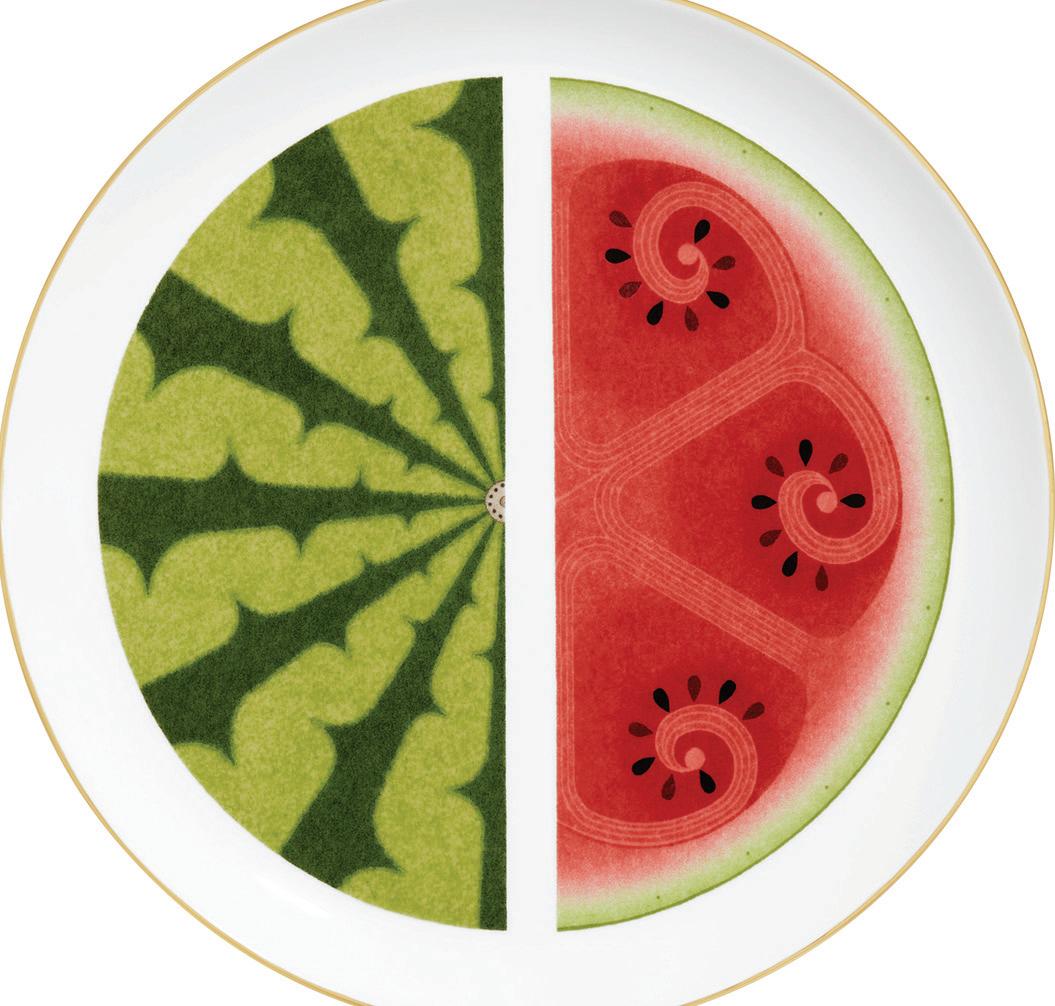
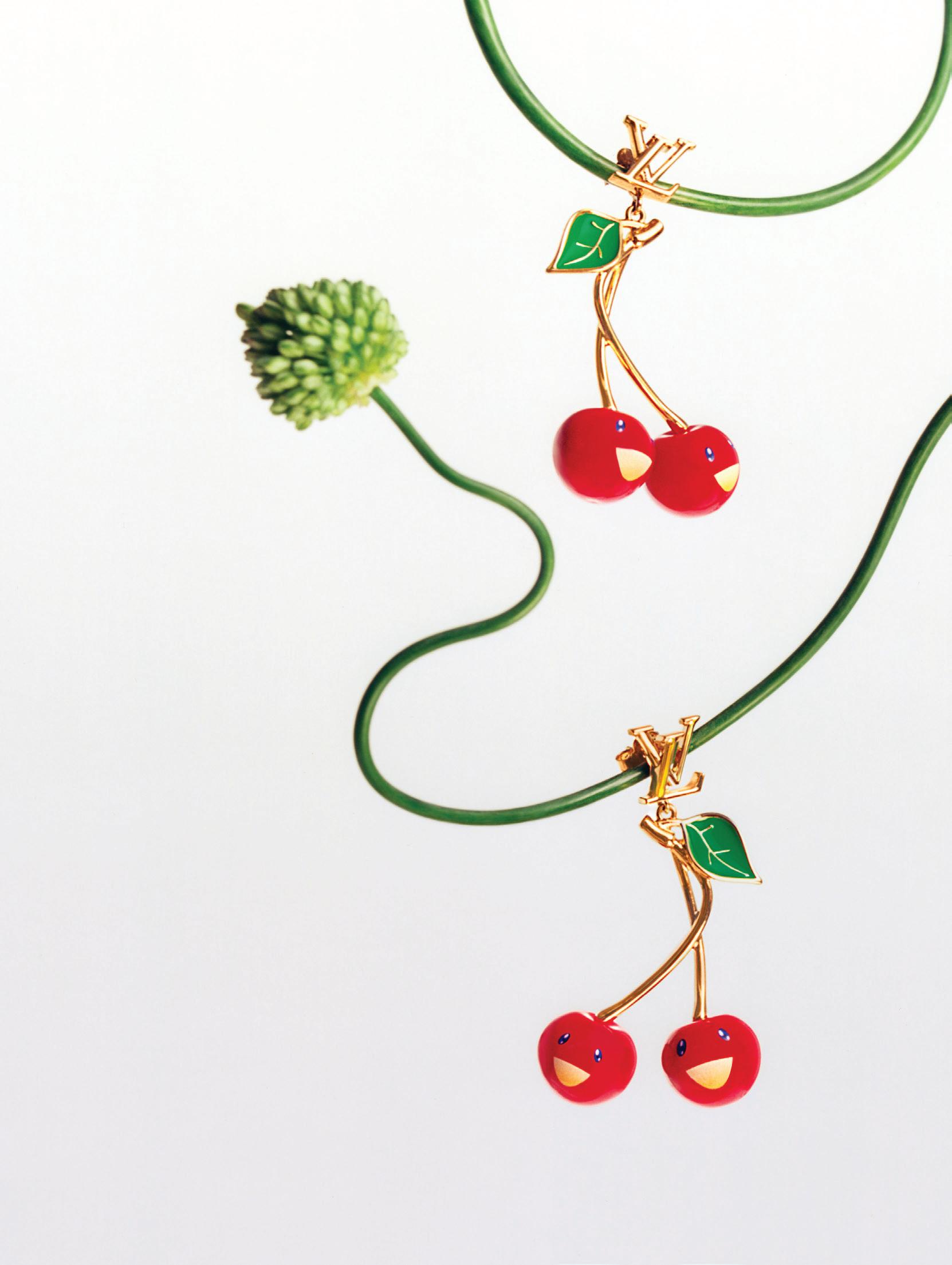

Sleek lenses in a glistening lime green—it’s Y2K energy with the sharpest of edges.
A cherry on top—literally—these baubles offer just enough kitsch to keep a look light and whimsical.



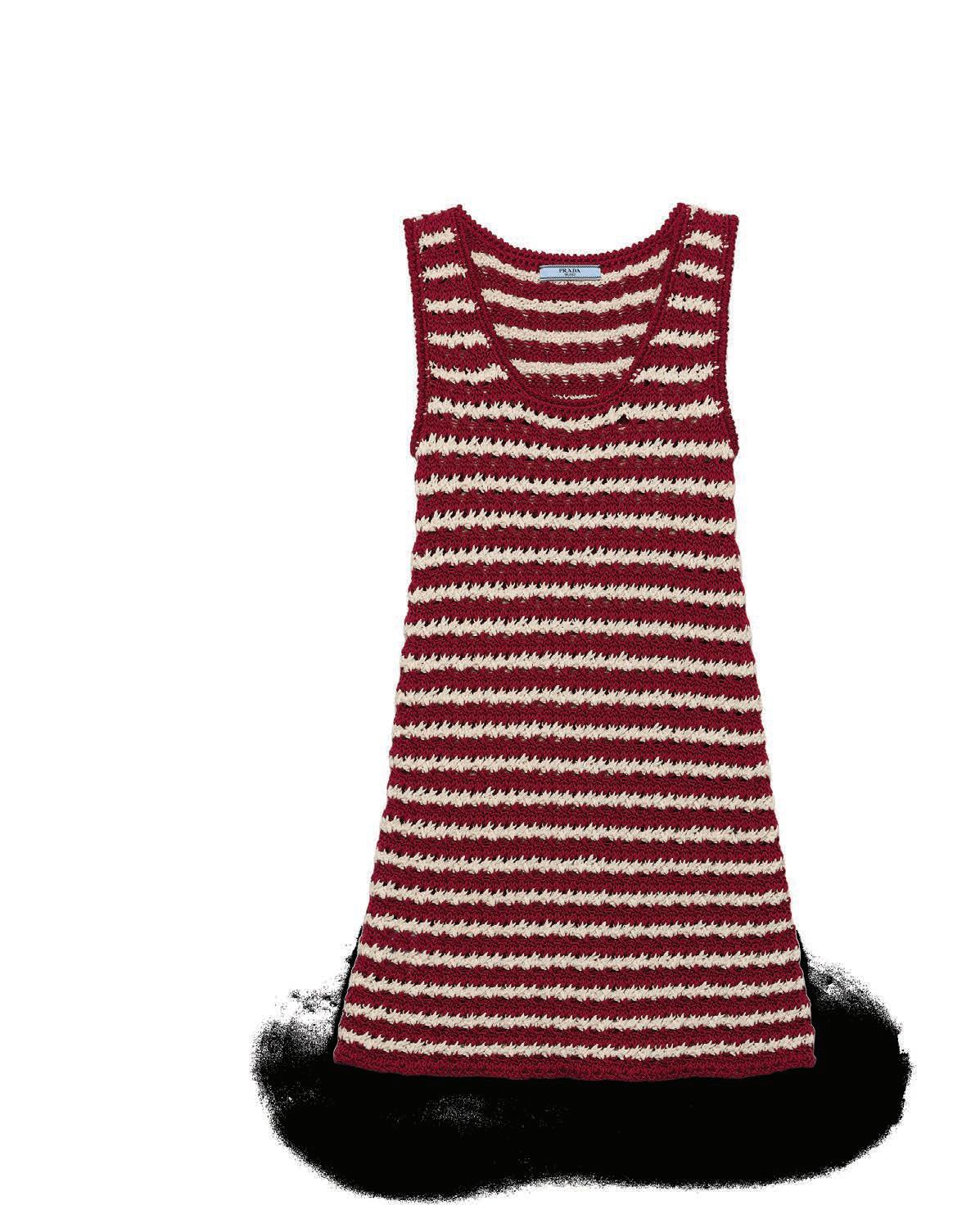

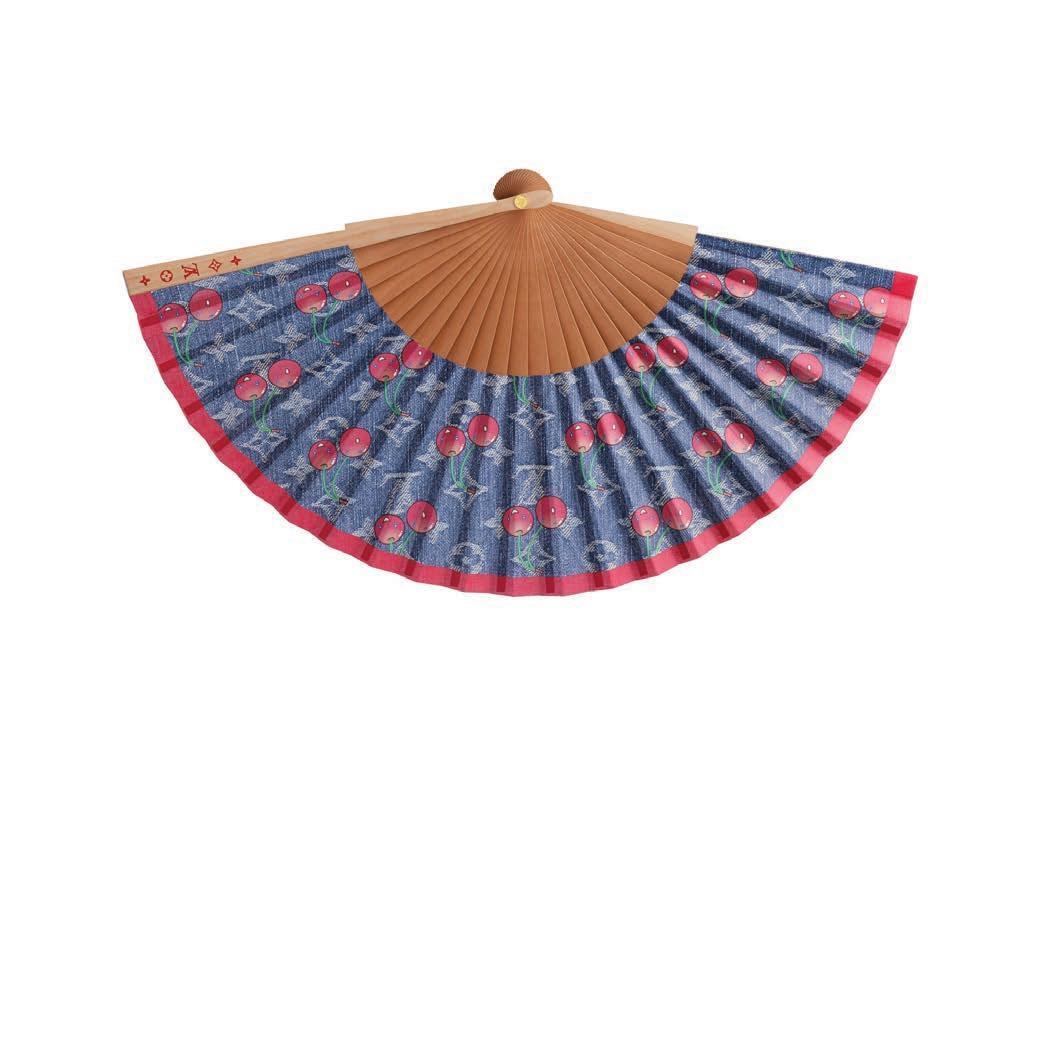


OUR SENIOR EDITOR SITS DOWN WITH THEIR UNCLE, DESIGNER JOHN GACHOT, FOR AN EXPLORATION OF A FAMILY LINE THAT HAS ENCIRCLED THE ART WORLD FOR GENERATIONS.
BY ELLA MARTIN-GACHOT PHOTOGRAPHY BY WILLIAM JESS LAIRD
Growing up, every visit to my grandparents culminated in a visit to the ice house.
Richard and Irene Gachot lived on a sprawling property abutting an even more sprawling property in Long Island’s Nassau County. Its gravel driveway, antique-filled farmhouse, and thick woodlands had been a labyrinthine playground for their five boys in the ’60s and ’70s, and became one for me three decades later. The ice house stood sentinel over this insular fantasy land— this was where my grandfather went about the business of being an artist. Wildly prolific, Dick made work with the vengeance of someone who had, legend has it, been forced to trade his dreams of more creative pursuits for the life of a Mad
Man after his father lost a backgammon bet. The sculptures he produced (many of them animated with the turn of a handle) were loud commentaries on societal ills, anarchic riffs on inside jokes, or R-rated puns that went way over my head as a kid. They were cranky, weirdly brilliant, and hard to live with, just like him.
If the ice house was his inner sanctum, Shelter Island was my grandfather’s eternal muse. He and Irene rented a house there every summer, and the antiHamptons hamlet’s beach detritus, town dump, and motley cast of characters were an unending font of material for him. Dick died seven years ago, but just over a mile from their estival refuge my uncle John found a space where his art could roam.
Away from the churn of Manhattan, where he runs an eponymous design studio with his wife Christine, he made his way back into a drawing and painting practice that had been for decades relegated to notebooks and bar napkins. In a shed on their Dering Harbor property, John’s easels, drawing sheets, and pastels coexist with a gaggle of Dick’s sculptures, engrossed in a never-ending dialogue. As the summer kicked off, I checked in with my uncle for his side of the story and a tour of his happy place.
Tell me where your story with the shed begins.
Christine and I had a little shotgun shack on Shelter Island, which barely had two bedrooms. Our boys were getting bigger,
and we were just on top of each other, so we knew we had to move. Fast forward to February 2017. There had been a house we were looking at, and the broker called to say it was available. There was this teeny little house out in the back, and I just assumed it was someone else’s property. We came back to buy the house, and they were like, “Do you wanna go check out the shed in the back?” I was like, “Wait, that’s a part of this?” I immediately claimed it and said, “This is gonna be where I finally expand beyond working in a notebook.”
Did you immediately make the link to your father’s ice house? Can you tell me what that space meant to you as a kid, and how you see its function as an adult?

Old Westbury—the house, the property, the Gardens, and all the little buildings on it—were magical in a lot of ways. And I think they were inspirational to me unconsciously for becoming a designer, not just an artist. The ice house was one of those places—it was always this mysterious building. It was a mid-19thcentury structure that he re-clad with all the interiors fully intact. It was his little arena, and it very much became a museum—the Richard Gachot museum. You’d go in and there was a little notebook where you’d sign in… The analogy ends there. With the shed, it was really about having a working studio, somewhere where the clutter of my life could gather— old and new paintings and drawings, parts

of chairs, control samples started piling up. That’s what gave it its own life to me.
Artists have such different relationships to who they let inside their studios, and when. Who do you let inside the space, and what’s your relationship to showing work that’s in progress?
I started my adult life determined to be an artist. Then I came to New York, understood the realities of life, and found myself doing less and less art—not so much because of the need to work to survive, but because of how intimidated and out of place I felt in the art world at the time. I had a job at Artforum, but I didn’t think the art world had anything to do with my art. I definitely didn’t want to share my artwork at that point. It took me a while to realize, I don’t really care if people see this. I’m not there to impress someone—I just want to make something. Part of that stems from the place you go to when you make art. For me, it’s one of the few times I don’t think. Every morning, I get up and I draw while everyone’s asleep. And in the shed, I leave drawings out. I could care less if the boys are flipping through things. I’ve found beer cans left out on drawings, and I honestly don’t mind because it takes the preciousness out of it. There’s a living quality to it.
When did you first think of yourself as an artist?
Look, there was a part of my life where I


was convinced I was gonna be the next [John Singer] Sargent. I don’t even know when it started, but I was a very visual kid. I had a very conservative education growing up. It always felt weird being the one kid who did really well in art class. Other people came in and killed time gossiping and flirting. I was like, This is my favorite part of the day. And during summers on Shelter Island growing up, we used to have this art show every year. The parents would “judge” the art, although I don’t know if anyone was ever not let in. There was a lot of joking and humor to it, but everybody submitted something. I took incredible pride in it; I was always hoping I would get an award.
You’ve worked as a designer for almost three decades. Do you feel like these practices have fed each other?
In college I was also really interested in furniture design. When I moved to New York, I had the teeniest apartments with no furniture, so I started cobbling together little things that allowed me to live in a civilized way. I would build a little shelf out of a scrap I found in the street and mount it to the wall next to my bed, and that would get a clip-on light. It’s a completely different process than decoration: It was really about function and need. And that’s still where I start when I design something today. My art found another format over the years, largely due to the space constraints. So, watercolor and gouache in notebooks or on sheets of paper, drawing and designing furniture.

I became an applied artist. You look at Finn Juhl or Chippendale, and you realize these guys were conveying information in the most beautiful way. But also you’re in a service business as a designer—people are coming to you with a problem to solve.
But you never gave up on art completely. I knew that one day, hopefully, if things worked out, my work life would allow me to do more art. Slowly but surely, that’s where we are. [Christine and I] talk about gathering a body of work that I can show, but I’m not worried about that. Maybe I’ll be 80 by the time I’m ready, but in the meantime I can still keep making it.



AFTER A WHIRLWIND YEAR MARKED BY A CAREER-DEFINING
APPEARANCE IN THE WHITE LOTUS , LESLIE BIBB COULD USE A BREAK. THE THING IS, SHE DOESN’T WANT ONE.
BY ESTHER ZUCKERMAN
PHOTOGRAPHY BY TERENCE CONNORS
STYLING BY LAURA FERRERA
SPECIAL THANKS TO THE HEDGES INN, EAST HAMPTON
Leslie Bibb isn’t quite sure how to slow down. “As actors, we’re always trying to get the next job,” she says. “I don’t like downtime much because I love what I do.”
But when we speak a few days after her cover shoot for this issue—a joyride in the eternally estival East Hampton—Bibb is taking something of a break. She’s in Upstate New York now, at the home of a “very fancy interior designer” friend, her dog Gus wrapped around her feet. From her perch, she has a view of some Canada geese and a pond. She’s taking a moment to relax.
In August last year, the North Dakota–born 51-year-old finished filming the third season of HBO’s much-discussed
vacation dramedy The White Lotus. She played Kate, a Texas mom on a girls’ trip to Thailand with two longtime frenemies portrayed by Michelle Monaghan and Carrie Coon. A couple of months later, she was back to work on the second season of the 1960s-set Apple TV+ comedy Palm Royale, which she followed up with a whirlwind White Lotus press tour, then capped that off with some Palm reshoots.
The White Lotus fervor was unlike anything she’d ever experienced before. The amount of attention the luxe murder mystery garners even surprised her partner, Sam Rockwell, whose infamous cameo marked a pivot point in the season. He tried to warn her. “He said, ‘Baby, it’s like when I won the Oscar, if not
more,’” she remembers. “‘I don’t think you are prepared for that.’” She wasn’t, but she enjoyed the ride all the same.
As the whirlwind winds down, it’s hard to let go of the experience. “You want to work with actors and filmmakers and writers and DPs who make you feel like you just get better and better,” Bibb says. “It’s made me a bit more discerning about my choices.” She wasn’t sure if audiences were going to like Kate, who reveals her conservative leanings in a scene that went beyond viral thanks to Bibb’s perfectly condescending flicker of a smile, but the actor grew attached to her character for her loyalty. “Kate’s the girl who’s never going to leave you at the bar,” Bibb says.
She even kept Kate’s signature haircut—a jaw-framing style that she and her stylist, Chris McMillan, call the “cunty little bob.” This was partly out of convenience—it was easy to fit under her Palm Royale wig—and partly because of the moment in her life that it has come to symbolize. “I can’t break up with her quite yet,” she says, tossing her locks.
For now, while Bibb awaits the yet-undated release of Palm Royale’s second season, there’s time for a moment of repose. She’s enjoying her getaway—even if the geese are making a mess of the sprawling lawn. “It’s really nice up here,” she muses. “Even with the goose poop.”




“SAM ROCKWELL SAID ‘BABY, IT’S LIKE WHEN I WON THE OSCAR, IF NOT MORE. I DON’T THINK YOU ARE PREPARED FOR THAT.’”
—LESLIE BIBB

“As actors, we’re always trying to get the next job. I don’t like downtime much because I love what I do.”
—LESLIE BIBB



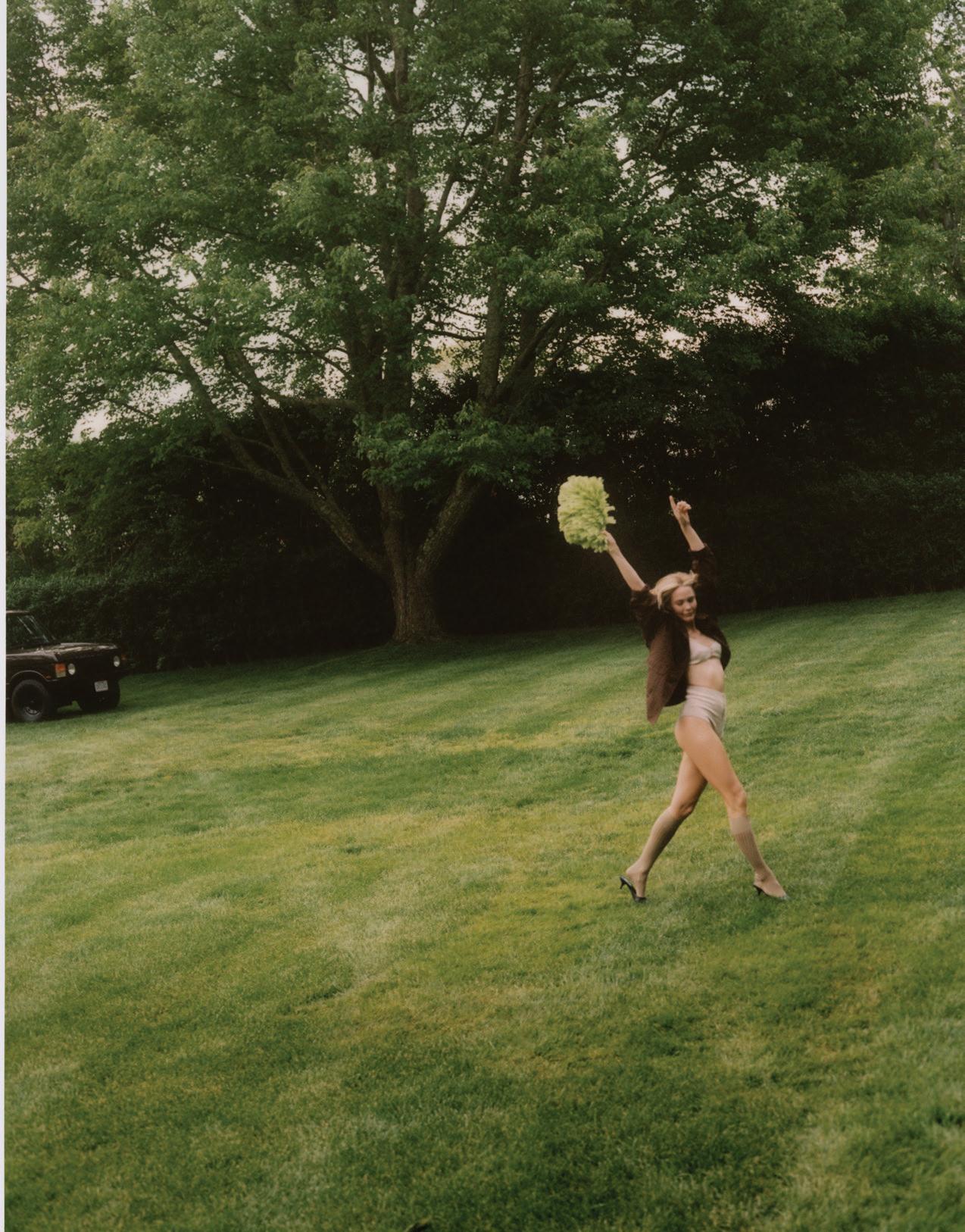
SHE EVEN KEPT HER WHITE LOTUS CHARACTER’S
SIGNATURE HAIRCUT—A JAW-FRAMING STYLE THAT SHE AND HER STYLIST, CHRIS MCMILLAN, CALL THE “CUNTY LITTLE BOB.”
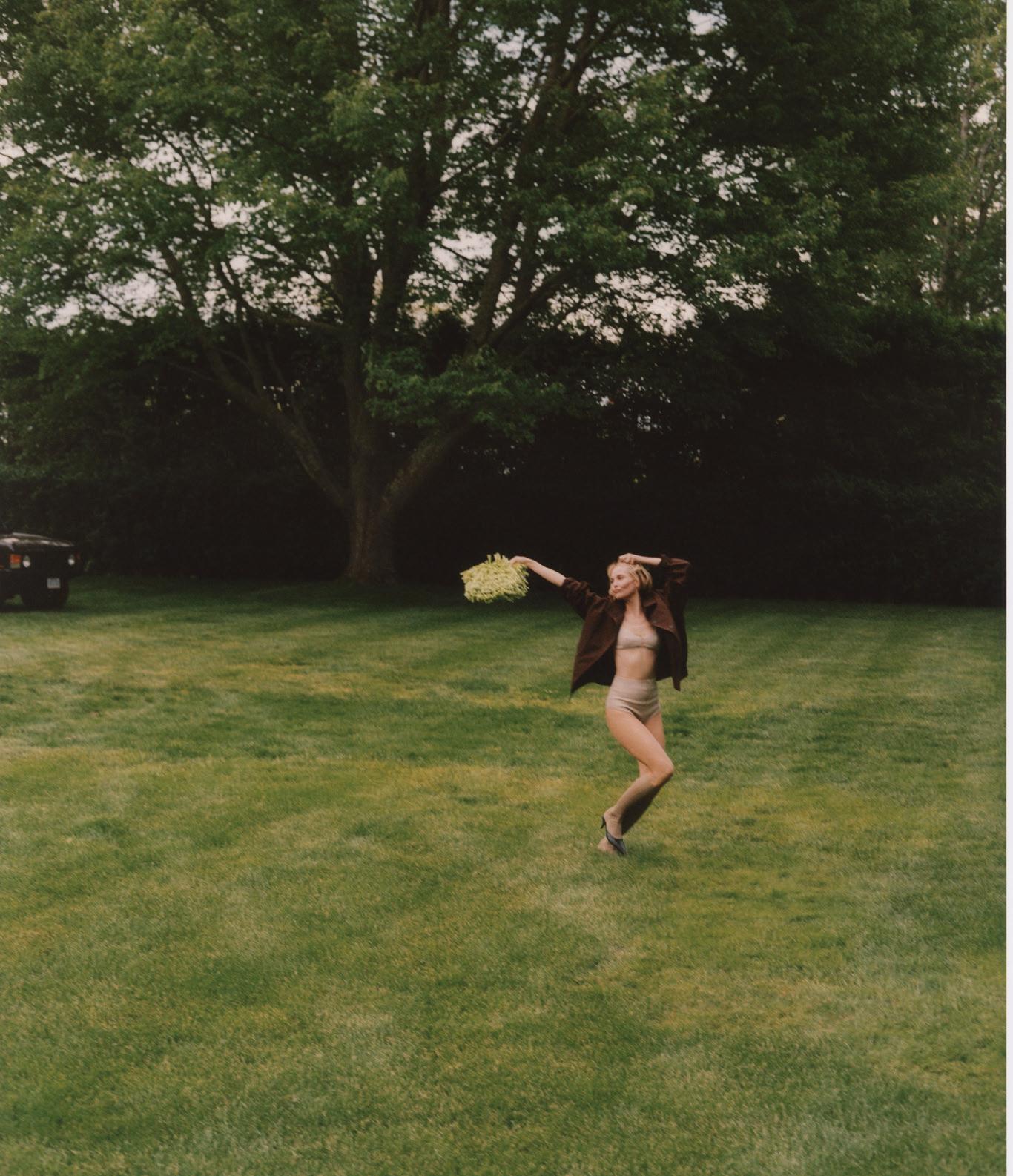




ILLUSTRATIONS BY ARTURO MÉNDEZ
“It’s sweet, charming, and very local. In addition to peaches, I’ll get my sunflowers and other seasonal blooms to make floral arrangements here. The kids and I love taking an afternoon stroll to sample goods and see what’s new.”
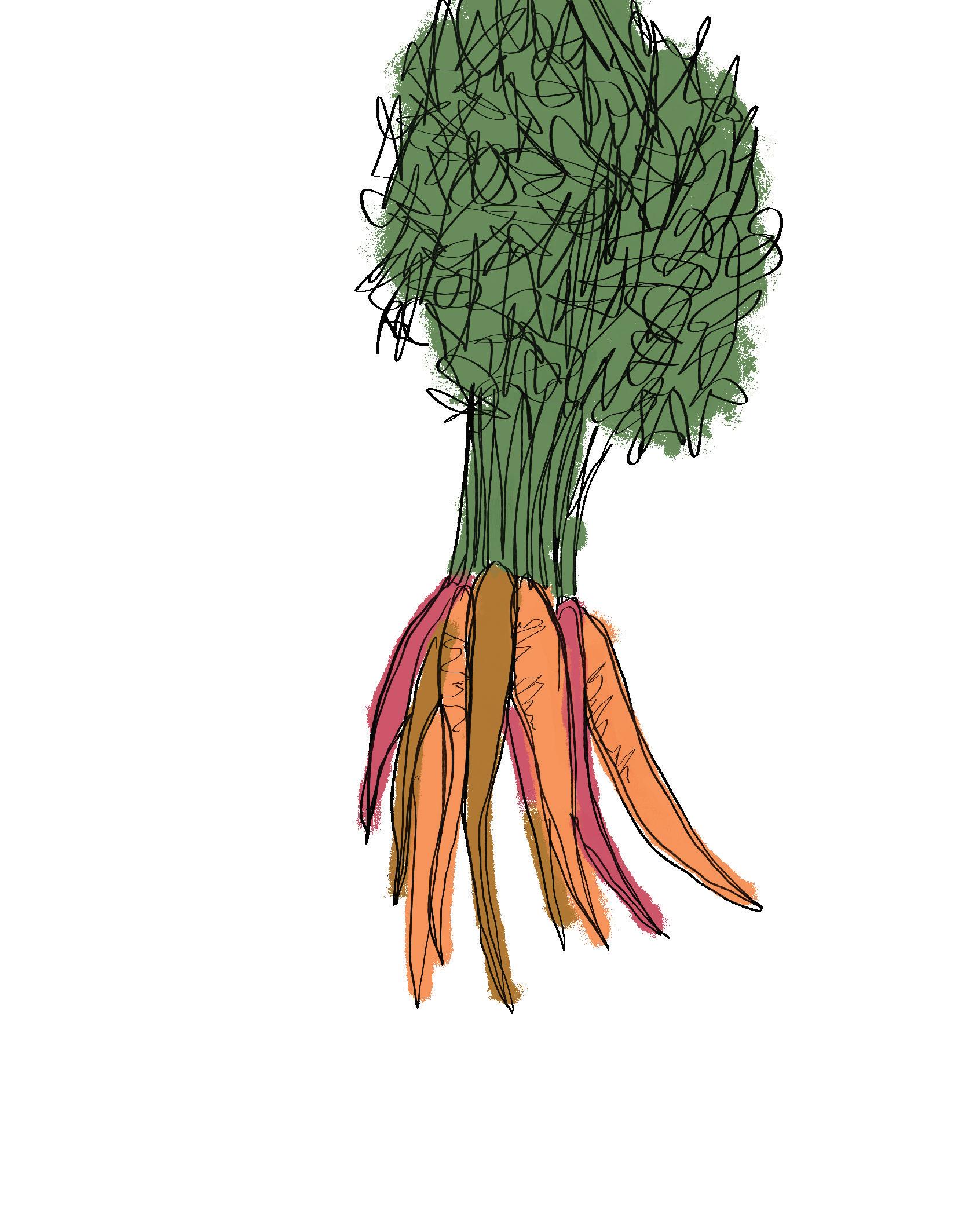

“They always have beautiful, fresh, hyperlocal produce that tastes like it’s plucked from the earth (because it is). It’s hard to go back to supermarket fruits and veggies once you cross over.”
JONI BROSNAN, THE HEART AND SOUL BEHIND MONTAUK’S COZIEST EATERY AND A NEWLY MINTED COOKBOOK AUTHOR, SERVES UP A LIST OF PURVEYORS FOR ALL THINGS LOCAL PRODUCE.
Joni Brosnan wasn’t born an East End year-rounder—she became one. The chef, who cut her teeth at New York staples Indochine and Sarabeth’s, traded a childhood of Montauk summers for resident status when she opened her eponymous restaurant in the hamlet in 2001. Over two decades, Joni’s Kitchen morphed into its own kind of local monument to fresh food, elbow grease, and good times, both on- and off-season. Her scrambles, wraps,
and, yes, libido-boosting smoothies have nourished generations of surfers, retirees, and celebrities alike—Cynthia Rowley, Julianne Moore, and Chris Martin are regulars. A new book, Joni’s: A Love Letter to Summer in Montauk, brings her homespun cooking to the masses. Because Joni’s wouldn’t be anything without the ingredients that make up its colorful menu, we asked Brosnan to give us her ultimate guide to the region’s farm stands.

“If you’re able to get a CSA [Community Supported Agriculture] membership, it’s fantastic. The best part is that you can harvest ingredients for your monthly boxes right on their property, literally picking out what you want. It keeps me creative in the kitchen and closer to my food. That dirtunder-your-nails feeling is romantic.”




“Montauk native Phil Yaz is deeply invested in terroir and protecting our planet’s soil health. He always brings just-harvested veggies to Joni’s and his sprawling farm offers CSA options that are dreamy.”
“Vicki started her farmstand when she was 11 years old and has been a community staple for more than four decades.”
“I’m always buying fresh eggs here to keep out on my counter. They’re unwashed as nature intended, and in turn can be left at room temperature. The golden yolks have the most wonderful, creamy texture that takes a simple egg on toast to the next dimension—and the colorful shells make great compost.”

FOR THE CREAMIEST FARMHOUSE CHEDDAR AND BEST THANKSGIVING TURKEY: MECOX BAY FARM, BRIDGEHAMPTON
“Don’t be shy to ask for tasters of the lifealtering cheeses.”

FOR THE LUSHEST VEGGIES: GREEN THUMB ORGANIC FARM, WATER MILL
“A mainstay out East with stunning grounds, frequented by chefs. It’s the kind of place where you can buy by the bushel or go for one—absolutely divine—apple. You’re instantly greeted with the aroma of rainbow-colored produce on arrival, and they have hard-to-find varieties like chocolate habaneros.”

